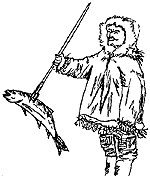|
In response to differing environments many cultures developed across
what is now Canada. These cultures, classified in seven groups
corresponding to the geographic regions, are the Northwest Woodlands,
Plains, Plateau, Pacific Coast, Eastern and Central Woodlands, Lower
Great Lakes-St. Lawrence, and Tundra. The Plains, the Northwest
Woodlands, the Eastern and Central Woodlands and the Tundra cultural
groups all, at times, occupied areas in what is now Manitoba.

The people of the Eastern Woodlands lived in either dome-shaped or
conical dwellings. Saplings formed the framework and rolls of
birchbark were used for covering. The covering was sometimes made of
skins or rush mats in winter and was fastened down with ropes of
spruce or secured by poles propped against it. Birch bark was a
mainstay and was used to make canoes, an invention which later became
indispensable to the fur traders. Snowshoes and toboggans were also
inventions of the Woodland people.

The people of the plains roamed the prairies in search of buffalo
which came from the south in summer to graze on the prairie grass. All
tribes had similar lifestyles which changed with the seasons. In early
summer many bands came together to form large encampments to hunt. To
ensure a successful hunt ,the people had to choose leader to guide
them and to coordinate the hunt.
In the subarctic woodlands of the Northwest, small bands of
Athapaskan-speaking people roamed in search of moose and caribou.
Their environment was severe and the terrain rugged. Since birch bark
was not plentiful in the Woodlands of the Northwest, other materials
such as spruce bark or woven spruce and willow roots and wood or bark
were used for canoes, cooking pots and dishes. For the most part,
people of this region led a hard life with little contact with any
other cultural groups.
In the harsh environment of the tundra region, winters were long and
frigid, the ground never thawed, there were no trees and little
vegetation. The Inuit were different from all other Aboriginal peoples
in looks and language as well as in lifestyle. There were no bands or
clans, but ten to twenty families might stay together for awhile and
then disperse to form new groups. 
In the summer, the Inuit lived in tents of seal or caribou skin. In
winter, many lived in domed shaped houses made of blocks of packed
snow. The people of this region developed several means of
transportation suited to their unique lifestyles. The kayak and the
larger umiak, both made of skin, were excellent for water travel. The
sled drawn by Husky dogs was used for travelling over the icy
landscape. The Inuit excelled at making tools and utensils from slate,
soapstone, antlers. bone. walrus ivory and baleen. and caribou sinew
and hides. |



